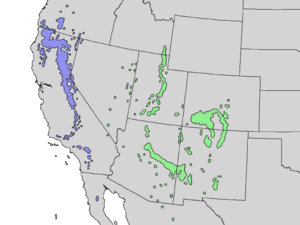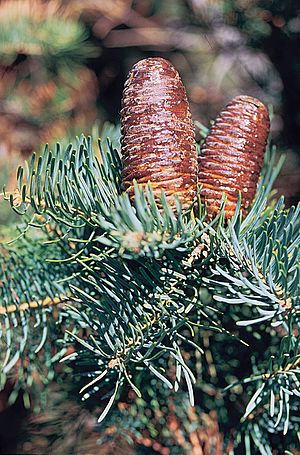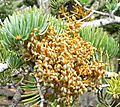White fir facts for kids
Quick facts for kids Abies concolorWhite fir |
|
|---|---|
 |
|
| Sierra Nevada white fir in Yosemite National Park |
|
| Conservation status | |
| Scientific classification | |
 |
|
| Natural range of Abies concolor
green - A. concolor var. concolor
blue - A. concolor var. lowiana
|
|
| Synonyms | |
|
The Abies concolor, also known as the white fir, is a type of coniferous tree. It belongs to the pine family, Pinaceae. This tree naturally grows in the mountains of western North America.
You can find white fir trees from Oregon, through California, and into northern Baja California, Mexico. They also grow east through parts of Idaho to Wyoming. Further south, they are found in Utah, Colorado, Arizona, New Mexico, and northern Mexico. White firs can live for over 300 years. They grow at high elevations, usually between 900 and 3,400 meters (2,950 to 11,200 feet) above sea level.
People often plant white firs in their yards as decorative trees. They are also very popular as Christmas trees. The name concolor means "all one color," which refers to its needles.
Contents
What Does the White Fir Look Like?
The white fir is a large evergreen tree. It grows best in the central Sierra Nevada mountains of California. The tallest white fir ever recorded was 74.9 meters (246 feet) tall. It was found in Yosemite National Park. The widest one measured 4.6 meters (183 inches) across its trunk. This measurement is taken at "diameter at breast height" (dbh).
Most white fir trees are between 25 and 60 meters (80 and 195 feet) tall. Their trunks can be up to 2.7 meters (8.9 feet) wide. White firs in the Rocky Mountains are usually smaller. They rarely grow taller than 38 meters (125 feet).
Leaves and Cones
The leaves of the white fir are like needles. They are flat and measure about 2.5 to 6 centimeters (1 to 2.4 inches) long. They are green to blue-green on top. On the underside, they have two blue-white stripes. These stripes are made of tiny pores called stomata. The needles are arranged in a spiral pattern on the branch. However, they twist at the base. This makes them look like they are in two flat rows.
The cones are the tree's reproductive parts. They are 6 to 12 centimeters (2.4 to 4.7 inches) long. They are also 4 to 4.5 centimeters (1.6 to 1.8 inches) wide. The cones start green or purple. They turn light brown when they are ripe. Each cone has about 100 to 150 scales. The seeds inside have wings. They are released when the cones break apart. This happens about six months after the tree is pollinated.
Types of White Fir
Scientists divide white fir into two main types. These are called subspecies. Sometimes, they are called varieties or even separate species.
Abies concolor subsp. concolor
This type is known as the Colorado white fir or Rocky Mountains white fir. It grows in the Rocky Mountains of the United States. You can find it from southern Idaho down to New Mexico and Arizona. It also grows in parts of Nevada and southeastern California. It even reaches a short distance into northern Mexico.
This subspecies is usually smaller. It grows to about 25 to 35 meters (80 to 115 feet) tall. Its leaves often curve upwards. They are usually 3.5 to 6 centimeters (1.4 to 2.4 inches) long. They are also very blue-green on the top. This type of white fir can handle very cold winters. Temperatures can drop to about -40°C (-40°F).
Abies concolor subsp. lowiana
This type is called Low's white fir or Sierra Nevada white fir. It grows in the Cascade Range of central Oregon. It also grows south through California to northern Baja California, Mexico.
This subspecies is larger. It can grow to 40 to 60 meters (130 to 200 feet) tall. Its leaves are usually flatter. They are about 2.5 to 5 centimeters (1 to 2 inches) long. They are not as blue-green on top. This type can handle winter temperatures down to about -30°C (-22°F).
Related Species
The white fir is very similar to the grand fir. The lowiana subspecies is especially like the grand fir found inland. They even mix where they meet in Oregon. In Mexico, other similar fir trees replace it. These include the Durango fir and the Mexican fir.
White Fir in the Forest
White fir is a "shade tolerant" tree. This means it can grow well even in shady spots. It is also a "climax species." This means it is a tree that grows in a mature, stable forest. For thousands of years, white fir and ponderosa pine trees have grown together. They form old-growth forests in their natural range.
In the past, people cut down many large trees. They also stopped natural wildfires. This caused many young white firs to grow. Some people in the lumber industry used to think white fir was a problem. But now, it is an important wood for building.
White fir trees keep their lower branches. These branches help smaller birds escape from bigger predators. They also help collect moisture around the tree's roots. However, these low branches can also act like a "fire ladder." This means flames can climb up them to the top of the tree.
Removing the lower branches of white firs can help protect other trees. This is especially true for giant sequoias. Giant sequoias are very good at surviving fires. Their thick bark protects them. Their cones also open and release seeds when they feel heat from a fire. The forest ecosystem needs a mix of trees like pine, fir, and oak.
Ecology
White fir trees are home to some other living things. For example, a plant called fir mistletoe can grow on them. This mistletoe is a parasitic plant. This means it lives off the fir tree. White firs can also be attacked by insects, like the fir engraver.
Dependent Species
Old white fir forests are home to many animals. These animals depend on the forest to live. Examples include the California spotted owl and the Pacific fisher. These animals use holes in large, old white fir trees for nesting or making their dens.
The Mount Pinos sooty grouse also needs large trees for shelter in winter. Its winter food is mostly white fir and yellow pine needles. Deer eat the leaves of white fir. Porcupines chew on its bark. Songbirds, grouse, and other small animals eat the seeds. Squirrels also spend a lot of time in the tree's branches.
Uses
White fir wood is popular for building. It holds nails well and is light. It also resists splitting and twisting. The wood is straight-grained and strong.
White fir is a favorite Christmas tree. Its soft needles stay on the tree for a long time. People also use its branches for Christmas decorations.
Cultivation
White fir is often planted in parks and large gardens. Some types have very bright blue-green leaves. One small type, 'Compacta', grows only to about 2.5 meters (8 feet) tall. It has won an award for its gardening qualities.
Gallery
-
A young sapling of subsp. lowiana on Mount Whitney
-
Small stand of young white firs on Cuyamaca Peak California
-
White firs at Toro Peak, CA.
See also
 In Spanish: Abeto del Colorado para niños
In Spanish: Abeto del Colorado para niños










